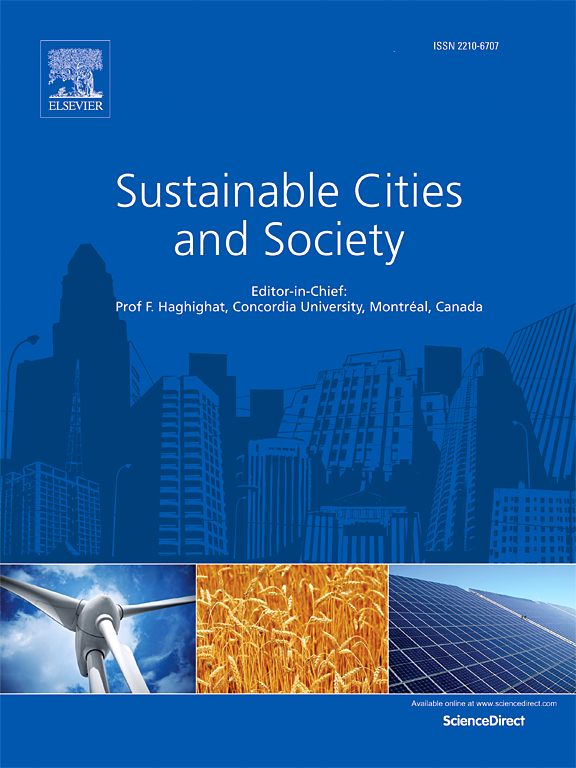Effect of solar photovoltaics on green roof energy balance and evapotranspiration
IF 10.5
1区 工程技术
Q1 CONSTRUCTION & BUILDING TECHNOLOGY
引用次数: 0
Abstract
Photovoltaic green roofs represent an emerging technology that combines on-site renewable energy production with the environmental benefits of green roofs. Detailed models for calculating energy fluxes on photovoltaic green roofs are presented, relying on accessible meteorological data and setup geometry as input data. A key focus is the accurate modelling of longwave radiation, an often-overlooked component of energy balance. Experimental results reveal up to a 100 W m-² difference in incoming longwave radiation on green roof surface under photovoltaics compared to open-sky conditions, demonstrating the significant impact on the energy balance. The precise modelling of short and longwave radiation is achieved through proposed shading and view factor calculation methods, as well as with a developed parametric model for green roof surface temperature under varying shading factors. Neglecting longwave radiation exchange with photovoltaic modules would result in an 18 % underestimation of daily evapotranspiration. A complete detailed model for evapotranspiration calculation is proposed, achieving a 4.4 % normalized root mean square error for daily predictions. By accurately estimating energy fluxes and evapotranspiration, this study provides tools for quantifying water needs, optimizing the synergy between green roofs and photovoltaics, and assessing their broader impacts on urban microclimates.
求助全文
约1分钟内获得全文
求助全文
来源期刊

Sustainable Cities and Society
Social Sciences-Geography, Planning and Development
CiteScore
22.00
自引率
13.70%
发文量
810
审稿时长
27 days
期刊介绍:
Sustainable Cities and Society (SCS) is an international journal that focuses on fundamental and applied research to promote environmentally sustainable and socially resilient cities. The journal welcomes cross-cutting, multi-disciplinary research in various areas, including:
1. Smart cities and resilient environments;
2. Alternative/clean energy sources, energy distribution, distributed energy generation, and energy demand reduction/management;
3. Monitoring and improving air quality in built environment and cities (e.g., healthy built environment and air quality management);
4. Energy efficient, low/zero carbon, and green buildings/communities;
5. Climate change mitigation and adaptation in urban environments;
6. Green infrastructure and BMPs;
7. Environmental Footprint accounting and management;
8. Urban agriculture and forestry;
9. ICT, smart grid and intelligent infrastructure;
10. Urban design/planning, regulations, legislation, certification, economics, and policy;
11. Social aspects, impacts and resiliency of cities;
12. Behavior monitoring, analysis and change within urban communities;
13. Health monitoring and improvement;
14. Nexus issues related to sustainable cities and societies;
15. Smart city governance;
16. Decision Support Systems for trade-off and uncertainty analysis for improved management of cities and society;
17. Big data, machine learning, and artificial intelligence applications and case studies;
18. Critical infrastructure protection, including security, privacy, forensics, and reliability issues of cyber-physical systems.
19. Water footprint reduction and urban water distribution, harvesting, treatment, reuse and management;
20. Waste reduction and recycling;
21. Wastewater collection, treatment and recycling;
22. Smart, clean and healthy transportation systems and infrastructure;
 求助内容:
求助内容: 应助结果提醒方式:
应助结果提醒方式:


